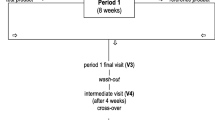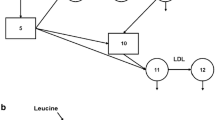Abstract
The effect of orlistat, a nonabsorbed inhibitor of gastric and pancreatic lipases, was examined in patients with primary hyperlipidaemia (serum cholesterol ≥6.2 mmol·l−1 and triglycerides ≤5.0 mmol·l−1) not responsive to dietary change alone. In a multicentre, randomised, double-blind study, 103 men and 70 women received 30, 90, 180, or 360 mg of orlistat or placebo for 8 weeks.
Total and low-density lipoprotein cholesterol levels were reduced by 4% and 5% with 30 mg orlistat, by 7% and 8% with 90 mg orlistat, by 7% and 7% with 180 mg orlistat and by 11% and 10% with 360 mg orlistat compared to placebo. High density lipoprotein cholesterol levels significantly decreased in the 360 mg orlistat group. Triglyceride levels significantly increased in the placebo group but not in the drug groups. Body weight decreased by 1.2 kg with 360 mg orlistat, despite a weight maintenance diet. Decreases in vitamin E and D levels occurred, although both vitamins remained within the normal range.
Adverse effects from the gastrointestinal tract were frequent, but led to discontinuation of therapy in only seven patients. Orlistat is a new therapeutic drug for the treatment of hyperlipidaemia that may be particularly useful among overweight patients. Its potential place in therapy will await long-term studies. Vitamin supplementation should be considered during treatment.
Similar content being viewed by others
References
Grundy SM, Denke MA (1990) Dietary influences on serum lipids and lipoproteins. J Lipid Res 31: 1149–1172
The Expert Panel (1988) Report of the National Cholesterol Education Program Expert Panel on detection, evaluation, and treatment of high blood cholesterol in adults. Arch Intern Med 148: 36–69
The Study Group, European Atherosclerosis Society (1988) The recognition and management of hyperlipidaemia in adults: a policy statement of the European Atherosclerosis Society. Eur Heart J 9: 571–600
Ornish D, Brown SE, Scherwitz LW, Billings JH, Armstrong WT, Ports TA, McLanahan SM, Kirkeeide RL, Brand RJ, Gould KL (1990) Can lifestyle changes reverse coronary heart disease? Lancet 336: 129–133
Henkin Y, Garber DW, Osterlund LC, Darnell BE (1992) Saturated fats, cholesterol, and dietary compliance. Arch Intern Med 152: 1167–1174
Hadvary P, Lengsfeld H, Wolfer H (1988) Inhibition of pancreatic lipase in vitro by the covalent inhibitor tetrahydrolipstatin. Biochem J 256: 357–361
Borgstrøm B (1988) Mode of action of tetrahydrolipstatin: a derivative of the naturally occurring lipase inhibitor lipstatin. Biochim Biophys Acta 962: 308–316
Hoffmann AF (1976) Fat digestion: the interaction of lipid digestion products with micellar bile acid solutions. In: Rommelk K, Goebell H, Bohmer R (eds) Lipid absorption: biochemical and clinical aspects. University Park Press, Baltimore, pp 3–21
Hauptman JB, Jeunet FS, Hartmann D (1992) Initial studies in humans with the novel gastrointestinal lipase inhibitor Ro 180647 (tetrahydrolipstatin). Am J Clin Nutr 55: 309S-313S
Riepponen P, Marniemi J, Rautaoja T (1987) Immunoturbidimetric determination of apolipoproteins A-1 and B in serum. Scand J Clin Lab Invest 47: 739–744
Catignani GL, Bieri JG (1983) Simultaneous determination of retinol and alpha-tocopherol in serum or plasma by liquid chromatography. Clin Chem 29: 708–712
Hunninghake DB, Stein EA, Dujovne CA, Harris WS, Feldman EB, Miller VT, Tobert JA, Laskarzewski PM, Quiter E, Held J, Taylor AM, Hopper S, Leonard SB, Brewer BK (1993) The efficacy of intensive dietary therapy alone or combined with lovastatin in outpatients with hypercholesterolemia. N Engl J Med 328: 1213–1219
Ramsay LE, Yeo WW, Jackson PR (1991) Dietary reduction of serum cholesterol concentration: time to think again. BMJ 303: 953–957
Levin EG, Miller VT, Muesing RA, Stoy DB, Balm TK, LaRosa JC (1990) Comparison of psyllium hydrophilic mucilloid and cellulose as adjuncts to a prudent diet in the treatment of mild to moderate hypercholesterolemia. Arch Intern Med 150: 1822–1827
Todd PA, Benfield P, Goa KL (1990) Guar gum. A review of its pharmacological properties, and use as a dietary adjunct in hypercholesterolaemia. Drugs 39: 917–928
Ripsin CM, Keenan JM, Jacobs DR, Elmer PJ, Welch RR, Van Horn L, Kiang L, Turnbull WH, Thye FW, Kestin M, Hegsted M, Davidson DM, Davidson MH, Dugan LD, Demark-Wahnefried W, Beling S (1992) Oat products and lipid lowering: a meta-analysis. JAMA 267: 3317–3325
Superko HR, Greenland P, Manchester RA, Andreadis NA, Schectman G, West N, Hunninghake D, Haskell WL, Probstfield JL (1992) Effectiveness of low-dose colestipol therapy in patients with moderate hypercholesterolemia. Am J Cardiol 70: 135–140
Rubinstein A, Lurie Y, Groskop I, Weintrob M (1991) Cholesterol-lowering effects of a 10 mg daily dose of lovastatin in patients with initial total cholesterol levels 200 to 240 mg/dl (5.18–6.21 mmol/l). Am J Cardiol 68: 1123–1126
Becker M, Staab D, Von Bergmann K (1992) Long-term treatment of severe familial hypercholesterolemia in children: effect of sitosterol and bezafibrate. Pediatrics 89: 138–142
Miettinen TA (1982) Effects of neomycin alone and in combination with cholestyramine on serum cholesterol and fecal steroids in hypercholesterolemic subjects. J Clin Invest 64: 1485–1493
Crouse JR, Grundy SM (1979) Effects of sucrose polyester on cholesterol metabolism in man. Metabolism 28: 994–1000
Miettinen TA, Kesäniemi YA (1988) Cholesterol absorption regulates cholesterol metabolism and within-population variation of serum cholesterol. In: Hyperlipidaemia and atherosclerosis, Academic Press, New York, pp 73–82
Thompson GR (1989) Lipid related consequences of intestinal malabsorption. Gut 81: 29–34
Kestin M, Clifton PM, Rouse IL, Nestel PJ (1989) Effect of dietary cholesterol in normolipidemic subjects is not modified by nature and amount of dietary fat. Am J Clin Nutr 50: 528–532
Dattilo AM, Kris-Etherton PM (1992) Effects of weight reduction on blood lipids and lipoproteins: a metaanalysis. Am J Clin Nutr 56: 320–328
Regnstrøm J, Nilsson J, Tornvall P, Landou C, Hamsten A (1992) Susceptibility to low-density lipoprotein oxidation and coronary atherosclerosis in man. Lancet 339: 1183–1186
Traber MG, Kayden HJ (1984) Vitamin E is delivered to cells via the high affinity receptor for low density lipoprotein. Am J Clin Nutr 40: 747–751
Author information
Authors and Affiliations
Rights and permissions
About this article
Cite this article
Tonstad, S., Pometta, D., Erkelens, D.W. et al. The effect of the gastrointestinal lipase inhibitor, orlistat, on serum lipids and lipoproteins in patients with primary hyperlipidaemia. Eur J Clin Pharmacol 46, 405–410 (1994). https://doi.org/10.1007/BF00191901
Received:
Accepted:
Issue Date:
DOI: https://doi.org/10.1007/BF00191901




